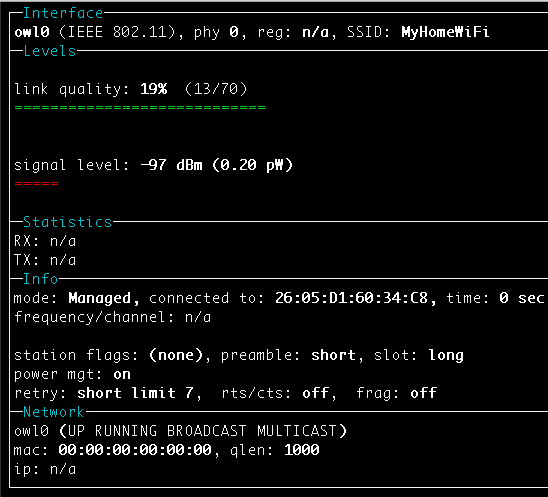vwifi implements a minimal interface to achieve basic functionalities,
such as scanning dummy Wi-Fi network, connecting, and disconnecting from it.
vwifi is based on cfg80211 subsystem,
which works together with FullMAC drivers. At present, it only supports station mode (STA).
The following packages must be installed before building vwifi.
In order to compile the kernel driver successfully, package versions of currently used kernel, kernel-devel and kernel-headers need to be matched.
$ sudo apt install linux-headers-$(uname -r)Since vwifi relies on the Linux wireless (IEEE-802.11) subsystem, iw is necessary for retrieving more information and configuring:
sudo apt install iwRun make to build the kernel module:
makeLoad cfg80211 kernel module:
sudo modprobe cfg80211Insert vwifi driver:
sudo insmod vwifi.ko ssid_list='[MyHomeWiFi][MyWifi_1][MyWifi_2]'Check network interfaces:
ip linkThere should be an entry starting with owl0, which is exactly the interface created by vwifi.
Bring up the network interface:
sudo ip link set owl0 upShow available wireless interfaces:
sudo iw devYou should get something as following:
phy#0
Interface owl0
ifindex 3
wdev 0x1
addr 00:00:00:00:00:00
type managed
Dump wireless information:
sudo iw listReference output:
Wiphy owl
max # scan SSIDs: 69
max scan IEs length: 0 bytes
max # sched scan SSIDs: 0
max # match sets: 0
max # scan plans: 1
max scan plan interval: -1
max scan plan iterations: 0
Retry short limit: 7
Retry long limit: 4
Coverage class: 0 (up to 0m)
Available Antennas: TX 0 RX 0
Supported interface modes:
* managed
Then, perform scanning:
sudo iw dev owl0 scanYou should get the following:
BSS ca:9c:00:c6:c2:eb(on owl0)
TSF: 0 usec (0d, 00:00:00)
freq: 2437
beacon interval: 100 TUs
capability: ESS (0x0001)
signal: -59.00 dBm
last seen: 0 ms ago
SSID: MyHomeWifi
SSID: MyHomeWiFi
Finally, we can connect to the dummy SSID MyHomeWiFi:
sudo iw dev owl0 connect MyHomeWiFiValidate the connection:
sudo iw dev owl0 linkReference output:
Connected to 26:05:d1:60:34:c8 (on owl0)
SSID: MyHomeWiFi
freq: 2437
Change wifi list:
echo -n "[MyHomeWiFi][MyWifi_1][MyWifi_2]" | sudo tee /sys/module/vwifi/parameters/ssid_list
SSID Naming Convention:
Don't put [ or ] in your SSID.
Also, the length of each SSID should be restricted between 0 and 32.
The default value of ssid_list is [MyHomeWiFi] if it's not specified explicitly by user.
Optional, you can use wireless device monitoring applications such as wavemon to
watch signal and noise levels, packet statistics, device configuration and network parameters of vwifi.
sudo apt install wavemonvwifi is released under the MIT license. Use of this source code is governed
by a MIT-style license that can be found in the LICENSE file.
- mac80211_hwsim: software simulator of 802.11 radio(s) for mac80211
- Emulating WLAN in Linux - part I: the 802.11 stack
- Emulating WLAN in Linux - part II: mac80211_hwsim
- virt_wifi: a completet virtual wireless driver that can be used as a wrapper around Ethernet.
- vwifi: simulate Wi-Fi (802.11) between Linux Virtual Machines.
